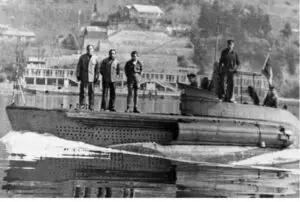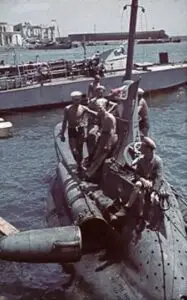Development and Features
In the 1930s, the aircraft manufacturer company “Caproni” had developed the first Italian midget submarines, the “CA” class, and built two units. These small vessels armed with 450mm torpedoes underwent a series of trials in which several issues emerged. The navy experts considered the CA too fragile and lacking sufficient manoeuvrability to conduct offensive actions against moving targets. Based on the testing experience, and the proposal for modifications, the Caproni factory developed an improved version of the vessels, which became the CB class. Two prototypes (CB 1 and CB 2) were ordered into production and were ready for sea trials in summer 1940.
The CB submarines had a displacement of 36-45 tons, 15 meters long and 3 meters wide, they could reach a maximum speed of 7,5 knots, emerged, and 6,5, submerged. The maximum depth they could reach was55 meters and their operational range was (emerged) 1000 nautical miles at 5 knots or (submerged) 60 nautical miles at 3 knots. Armed with two 450mm torpedoes, they had a crew of 3-4 men. The propulsion was granted by a diesel engine (90 HP) and an electric engine (100 HP). Compared to their predecessors of the CA class, the CB were bigger, more manoeuvrable and equipped with more powerful engines.
After successfully passing the sea trials in summer 1940, four more units were ordered (CB3-6) and together with the first two, entered service between January and May 1941. In total, 24 CBs were built by the Caproni factory, while the other 29 units were never completed.

A CB submarine during trials
Operational history
Surprisingly, the theatre of operations that saw the deployment of the small CBs was not the Mediterranean but rather the Black Sea. In late 1941, the failure of the German Army in capturing the whole of Crimea and its capitol Sevastopol forced the Germans to engage in a long siege. The Soviet Navy was lending troops and supplies in Crimea, the Luftwaffe was not able to stop this flow, nor the Kriegsmarine had assets in the area. During a meeting between the heads of the Regia Marina and the Kriegsmarine, on the 14th December 1941, Admiral Reader requested Admiral Riccardi to send naval reinforcements to the Black Sea in the form of M.A.S. boats and Submarines. This was perhaps the only time in the war when the Germans openly requested Italian aid in the war. In around three months, the Regia Marina assembled a new “flotilla” comprising of nine motor torpedo boats (five MTSM type and four M.A.S types), five explosive motorboats (MTM) and six CB (from CB1 to CB6). This new flotilla was commanded Francesco Mimbelli, who had distinguished himself for his daring actions aboard the torpedo boat “Lupo” during the Battle of Crete. After all the naval units were transported from Italy via rail, the flotilla finalized its deployment in Yalta (Crimea) by May 1942 and its operational cycle coincided mainly with the second battle for Sevastopol (May-June 1942).

A CB in a base in the Black Sea
During this short-lived campaign, the CB scored three major successes against the Soviet navy and its units re-supplying Sevastopol. On the 15th of June 1942, the CB-3 sunk the soviet submarine SC 213 while the CB2 two days later the CB-2 sunk the 1000t submarine S.32. In the same days, the Italian base at Yalta became subject to Soviet attacks and on the 13th of June, the CB-5 was sunk in one of the Soviet raids. Sevastopol fell in the first days of July 1942, and with the conclusion of the siege, the Italian flotilla on the Black Sea saw a long period of inactivity and one “likely” success, with the submarine SCH-207 sunk by CB-4 in August 1943.
Fate of the units

Crew members outside their unit
With the armistice of September 1943, the Germans captured all the five remaining submarines in the harbour of Constanța and transferred them to the Romanian navy. They were subsequently transferred back to the M.N.R., the small navy of the Italian Social Republic (the puppet state led by Mussolini and installed by the Germans in northern Italy from 1943 to 1945). There are no evident records on their service during this period and the five units were sabotaged by their crews before the Red Army entered Constanța in August 1944. Most of the other units available (17) in Italy, were transferred by the Germans to the M.N.R., again with no relevant track record. While most of the other units under construction were scrapped for metal.
Today only two CB still exist, one is the CB-20 at the Science Museum of Zagreb (Croatia). This unit was found semi sunk by the Jugoslav partisans in Pola and put back in service in the Jugoslav navy after the war. The second unit is the CB-22, which can be admired in Trieste (Henriquez Museum).
Sources
Bagnasco, E., & Brescia, M. (2013). I sommergibili Italiani1940-1943, Parte I – Mediterraneo.
Giorgerini, G. (1994). Uomini sul fondo.